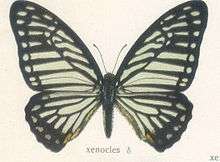Graphium xenocles
Graphium xenocles, the great zebra, is a swallowtail butterfly found in Southeast Asia which is common and not threatened.[1]
| Great zebra | |
|---|---|
 | |
| Male in Adalbert Seitz's Macrolepidoptera of the World | |
| Scientific classification | |
| Kingdom: | |
| Phylum: | |
| Class: | |
| Order: | |
| Family: | |
| Genus: | |
| Subgenus: | Pathysa |
| Species: | G. xenocles |
| Binomial name | |
| Graphium xenocles Cramer, 1775 | |
Description
Male upperside: black forewing with the following greenish or bluish-white streaks and spots: Cell with three transverse, very oblique, broad streaks and two elongate spots near apex; in the type as described the outer two of the three streaks coalescent; broad streaks from base in interspaces la to 3; a series of four rounded spots beyond apex of coll in interspaces 4, 5, 6 and 8, followed by five short streaks that are outwardly truncate or emarginate, in interspaces 4 to 8; lastly, a complete subterminal series of comparatively large rounded spots. Hindwing with similar greenish-white or bluish-white streaks and spots as follows: a broad curved streak in cell; broad streaks from base in interspaces 1 to 7, these streaks vary in length but invariably leave a comparatively broad margin of the ground colour beyond; the streak in interface 7 white, that in interspace 1, and in some specimens in interspace 2 also, with a large yellow spot beyond the apex; lastly, a subterminal series of spots, some or all of which may be absent, but when present the posterior three always somewhat lunular. Underside: fuliginous brown, paler towards the apical area of forewing; markings as on the upperside, but duller and less clearly defined. Antennae, head, thorax and abdomen black; two spots on the head, the thorax and abdomen laterally, white; beneath: the thorax and abdomen white, the latter with a medial and a lateral narrow stripe.[2]
Female similar to the male with similar markings; those on the hindwing often vary in width more than they do in the males; the ground colour also of the hindwing is generally of a chestnut red, not black or fuliginous.
See also
| Wikimedia Commons has media related to Graphium xenocles. |
| Wikispecies has information related to Graphium xenocles |
References
- Collins, N. Mark; Morris, Michael G. (1985). Threatened Swallowtail Butterflies of the World: The IUCN Red Data Book. Gland & Cambridge: IUCN. ISBN 978-2-88032-603-6 – via Biodiversity Heritage Library.
- Bingham, C.T. (1907). The Fauna of British India, Including Ceylon and Burma. II (1st ed.). London: Taylor and Francis, Ltd.